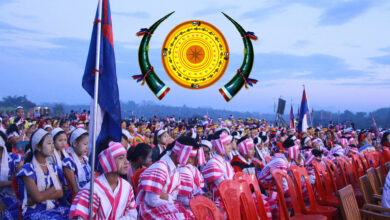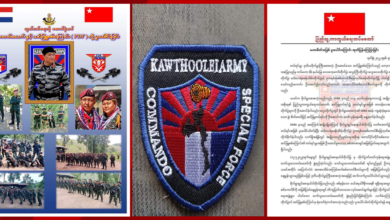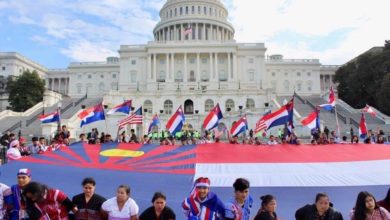Interview with Saw Thamein Tun

Padoh Saw Thamein Tun, a member of the Karen National Union’s Central Executive Committee explains to Karen News the significance of Karen National Day
KNU Day is a very special issue for the whole of the Karen nation. There were many various Karen Organizations in the past. In 1881, the Karen National Association (KNA) became the first organization of the whole Karen Nation. Thanks to the KNA’s efforts, education in the Karen nation has improved, and Karen culture and literature was allowed to be officially taught in government schools. After World War I the Karen people developed a greater sense of nationhood.
Karen people became more aware of the political situation in Burma. Karen Buddhists formed the Buddha Karen National Association (DKNA) and it became one of the biggest groups of the Karen nation. Before the World War II started, the Karen Youth Organization (KYO) was formed. There were thus three groups during the colonial era : the KNA, DKNA, and the KYO. After World War II, conflict broke out between the Burma Independence Army (BIA) and Karen groups. At the time, the Karen people were brutally tortured and oppressed by the BIA. The situation was particularly bad in Myaungmya Gen, the Deltas and the Eastern Papun areas.
During the Japanese occupation, Karen leaders formed the Karen Center Organization (KCO) in order to avoid future conflicts. Four Karen groups existed: the, KCO, KYO,KNA, and DKNA.
The political situation in Burma flared in the wake of World War II; the country split between the west, which favored capitalism, and the east, which supported socialism. Political stability further deteriorated as other regional states were fighting for independence from colonial powers, and nations of peoples sought to establish their own states. During this period, Karen people were in turmoil and there was no stability that would allow the formation of a Karen State. Yangoon Division did not exist at the time, and some people were demanding the Deltas and Pegu Division to recognize a Karen State that would include the eastern Yoma highlands and the whole area of Tenasserim coastal area. Others wanted the Deltas as well as the whole eastern region to be included, whilst others wanted the whole of Tenasserim Yoma region to recognize their state. These differences in opinion only worsened existing political tensions. In an effort to establish harmony, the KNA held a meeting in 1947 in Yangoon. The meeting decided that Karen people should speak with one voice and one group, and so the Karen National
Union was formed on February 5, 1947, by joining the four existing Karen organizations time – the KNA, the BKNA, the KCO and the KYO. The remarkable formation of the KNU is crucial when examining Karen history.
The KNU represents all Karen people, regardless of religion: Buddhist, Christian, and animists. It has played a crucial role in Karen history. The KNU has been working to achieve progress on political issues, equal rights, and a genuine federal union for the Karen nation. As such, the KNU is the main organization responsible for the advancement of unity among Karen groups.
This was a time when colonized countries were striving to gain independence; stateless people were fighting to establish their own states. Karen people were also fighting for a Karen state, but were so far unsuccessful. The Burma of Pyaymagyi included Mon, Burman, Karen and Rakhin , and so Karen people attempted to establish an independent state. We started calling for self-determination and autonomy of the Karen State. The purpose of forming the KNU was to gain equal rights and the right to self-determination for the Karen people. The Leaders of the KNU at that time were Saw Ba U Gyi, Saw San Poe thin, and John Cindy Poe Min. The first chairman of the KNU was Saw San Poe Thin. During Saw San Poe Thin’s leadership, the political situation was unstable and the KNU faced challenges to its internal unity. Soon after the KNU was formed, the KYO broke away from the KNU. Moreover, Saw San Po Thin left the organization for reasons of ideological disagreements. On April 10, 1947, the Central Executive Committee was reorganized with Saw Ba U Gyi as president and Saw Ba U Gyi replaced Saw San Po Thin as chairman. Saw Ba U Gyi led the KNU and struggled for the Karen nation until he died. The Karen top leaders mainly acknowledge Saw Ba U Gyi as the primary leader.
The KNU is important for the whole Karen nation. In the colonial era, many Karen people were educated and were civil servants of the government. At that time, the KNU was calling for self-determination on behalf of the whole Karen nation.
Burma declared independence on 4th of January 1948. Saw Ba U Gyi met with Minister U Nu and asked for an autonomous Karen State. U Nu said, “You, only leaders and educated people want a Karen State. How about poor people and grassroots people? Will they want to? Show me their desires.” The KNU generated a nationwide debate on whether the Karen people wanted to get their own State or not. Organized by the KNU, on February 11, 1948, tens of thousands of Karen people took to the streets throughout the whole country and demonstrated peacefully to demand an autonomous Karen state, and to show the world that it was the whole Karen people’s desire for a Karen state. The demonstrations argued four points:
1. The immediate granting of autonomy for a Karen State
2. Equality between Burmese and Karen people
3. The rejection of communal strife
4. The rejection of civil war
These four slogans were brandished on banners during the demonstrations.
General Aung San told Saw Ba U Gyi that Burmese and Karen people must be equal. These were peaceful protests, with over 456, 000 Karen people taking part. The Anti Fascist People’s Freedom League (AFPFL) government also knew that all Karen people wanted a Karen State.
Karen people from Deltas could not speak Karen, and so as far as the Burmese were concerned, these villages were Burmese. However, every house from those villages flagged the Karen flag on February 11. In the past, Burmese people considered them to be Burmese villages, but now they all knew that those were villages with Karen people. U Nu also was scared and said “Ha! As Karen people know themselves as Karen, our Burman people dare not to move our ears.” The demonstration showed that not only Karen officials and educated people wanted a Karen State but also the entire Karen population. However, U Nu told to Saw Ba U Gyi that Burma could not grant Karen people a separate state, and so they would have to kill each other.
Saw Ba U Gyi replied, “We will demand a Karen State from Luttaw. The demonstration has just shown the strength of Karen people. Your politics in Burma also have internal conflicts so you cannot only blame the Karen people. Problems in Burmese politics complicates ethnic politics.” So we need to learn lessons from this period.
The famous posters carrying the four slogans have been preserved. The KNU desires peace, so the KNU continues to work to achieve a genuine peace.
The 11th February is the anniversary of the four slogans. They symbolize what Karen people have always felt in the hearts. However, it was not until that day that Karen people formally articulated those ideas. The slogans emerged from Rangoon, Insein, Pathein, Myaungmya, Bokalay, Tharyarwadi, Nyaung Lay Pin, and Toungoo. They also emerged from Karenni and Shan areas as known as Kayar, Loikaw, Mawchi, and Tounggyi. People from Pa-an, Taton, and Kyarinnseikkyi also eventually joined.
Nowadays Karen young people do not feel like reading about history. So we provide training to young people about those issues and we have had some success. We have released some books. Nowadays it is important to study the literature and the young people should actively participate in national events.
The KNU has lasted because of public support. We have demanded rights for Karen people within the legal boundaries created by Saw Ba U Gyi. We did not call for a revolution. We are not rebelling against the government. The revolution that occurred was because of the AFPFL government’s constant coercion.
So when the current government welcomed peace, we were very pleased. We are very enthusiastic in demanding Karen nation rights by democratic political means without losing educated young Karen young and causing trouble for the public with sanguinary fighting. This time we will honor the ceasefire that we have discussed with the president U Thein Sein. We will work on researching how to achieve Karen nation rights and cooperate with other ethnic groups that desire democracy.
Revolution is not a bed roses and it is not a charity show that invites people to have food. The revolution can be harsh, it can be tiring, and people may starve and die. If a person dies, it is good. But when disabled people or handicapped people or injured people know how difficult their live are, some people leave the group. Finally, the KNU has people who are patriotic and who are able to make strong political decisions.
Now we live in the information technology era, so the KNU is slandered sometimes. Some KNU people are slandered too. However, we can endure those slanders. In summary, I want to say we just need to move forward on what we are working on with the best of our ability.




